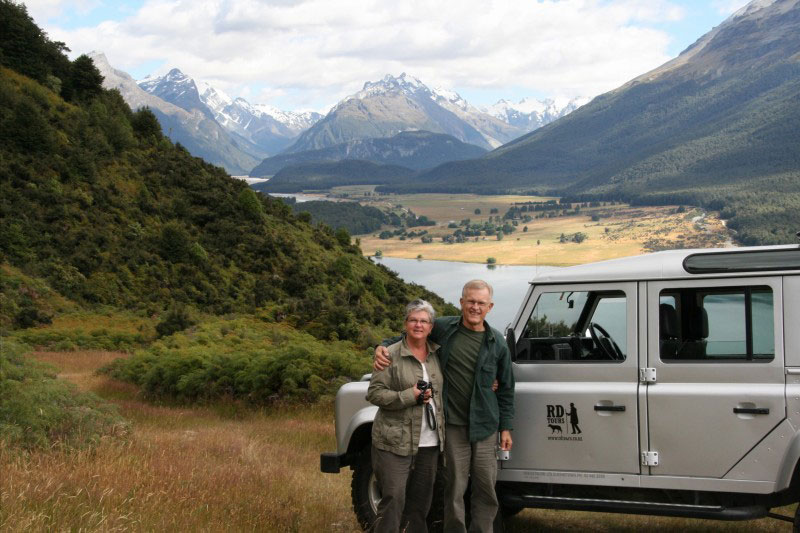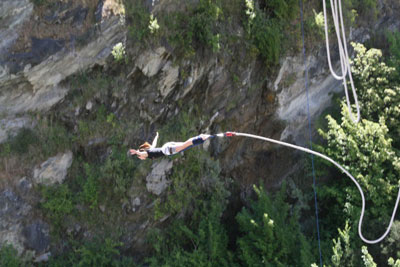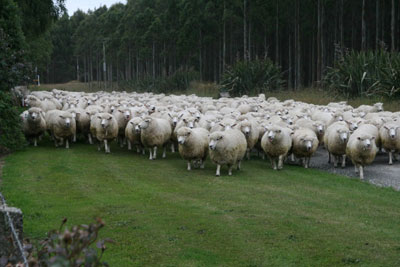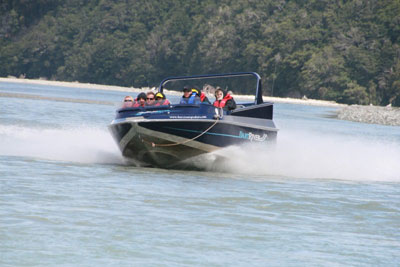From lush forests to glacial landscapes – getting to know New Zealand on a 3-week tour
This article appears on page 6 of the August 2013 issue.
New Zealand consists (mainly) of two islands. The smaller North Island has most of the country’s four-million-plus inhabitants and is generally warmer than the South Island. My wife, Betty, and I spent three weeks in New Zealand in January ’12. You need three weeks.
Russell
We picked up our car (the only rental car at the small airport in Kerikeri) and asked the agent for directions to Russell, where we were to spend the next three nights. She said, “Follow me. I’ll get you to the turnoff. You can’t miss it from there.”
After adjusting the mirrors and talking myself through the right-hand drive, I headed out of the airport parking lot and there she was, parked on the side of the road waiting for us. Twenty minutes later she pulled over and waved us on. We waved back and said “Thank you!” through the window and were on our way.
To get to Russell, we had to take the car ferry. (Ask for a return ticket, which is cheaper than two one-way tickets.) Once in Russell, we used the passenger ferry to get to all the sights, including those in Paihia, across the bay.
We stayed at the Ounuwhao B&B, a quaint, old farmhouse that was moved to its present location about 10 years before. The floors and paneling were made of prized kauri wood, now a protected tree in New Zealand. After a day’s sightseeing, we would take our bottle of wine and sit on the veranda and listen to the birds.
The bay at Russell was about 66°F, which made our swim with dolphins pretty nippy. When we arrived at the location where the dolphins were swimming, we joined a group of about 20 people all wearing their “swimmers” (bathing suits) and dove in.
Swimming with dolphins means you are in the same general area as dolphins. A couple came close but were moving too fast for photos — basically a gray blur in front of our masks and then they were gone.
It took a good 10 minutes to become acclimated to the water temperature, after which it was not that bad.
An insider’s perspective
The Maori culture is ever present on the North Island, as there is a much higher concentration of Maori in the north than in the south.
Our private guide, Kena Alexander, a descendant of one of the 40 or so Maori chiefs who first signed the Treaty of Waitangi with the British, provided us with an in-depth discussion of the culture of the Maori. He showed us the good and the not-so-good aspects of the Maori’s current condition, taking us to historical sites as well as to some areas where the Maori have not been able to keep pace with the rest of New Zealand.
Kena’s willingness to show us both sides enhanced our understanding of New Zealand as it is today, and we thank him for his candor.
Heading south
From Russell we drove south to Auckland, stopping along the way to walk through magnificent forests full of an endless variety of ferns, from huge tree ferns that towered over our heads to small ones on the forest floor. Every square inch of forest was covered with something green.
The moderating effects of the nearby ocean (nothing is farther than 75 miles from the sea) ensures constant, often wet, growing conditions. This is where we visited the famous Waipoua Forest and saw the magnificent kauri trees, some of which are over 2,000 years old and many feet in diameter.
Only after reading an article in Smithsonian magazine, provided by Karolyn Wrightson, who organized our trip, did I better understand what we were looking at. These trees were truly amazing! The little box we purchased, made from a 35,000-year-old piece of wood dug from a farmer’s field, was now all the more significant.
From Auckland we flew to Blenheim, landing with a 50-knot crosswind, which made for quite a ride in the small plane. Flights on this route are subject to frequent delays (20%-50% are delayed), so consider this when planning an activity upon landing. We missed a whale-watching trip because of it. (Though, as it turned out, the whale-watching trip, itself, was canceled due to high seas caused by very high winds.)
From there we drove across the island to the Punakaiki Resort, an excellent place to stay. Our room up the hill had excellent views of the ocean.
The weather there during our stay was stormy and it rained most of the time. We ventured onto the beach between rain squalls and watched the waves crash against the Pancake Rocks.
The Pancake Rocks are exactly what they sound like. Imagine a bunch of pancakes the size of trash can lids stacked in huge piles and then squashed together. Those piles are then formed by the sea and wind into an endless variety of shapes.
Right across from the rocks was a café that I’d recommend. It serves basic café food and is about a mile from the resort, but you will save a bundle compared to dining at the restaurant at the Punakaiki Resort.
During our travels in New Zealand, we found food to be about twice as expensive as in the US. What would be a 20-dollar meal at, say, Chili’s would cost you NZD40-NZD50 ($32-$40). I ate fish-and-chips most of the time and the price ranged from NZD16 to NZD35.
Other travelers we ran into always mentioned the high price of food. Expect to spend about $100 a day on food for two people. We tried to buy ready-made sandwiches or supplies from a grocery store when we could.
An exciting ride
Our next stop was Charleston, 28 kilometers north. There, we were issued wetsuits before heading up to the Glowworm Cave via a little train. It was pouring rain when we got there and we were the only two people on that trip.
The cave, itself, is worth a visit. It is fairly narrow and long, with many interesting features. About halfway through, we met the river. At that point, we got into our inner tubes and floated out of the cave and down the river to the starting point.
At first we saw only one or two glowworms at the top of the cave, then more. Finally, thousands of little lights shone from the ceiling. It was magical!
These small worms, the larvae of gnats, actually, are each about the size of a number-2 pencil lead and about one inch long. They dangle a foot-long “fishing line” in hopes of snaring a flying bug, using the light in their hind ends to attract them.
As we entered the cave, the guide pointed at a 2-foot-high marker in the water. Another foot or so and the river would be too high to raft. As we headed downstream, it quickly became apparent to the guide that the water was getting too high to be safe, but it was too late to turn back. By the time we got to the take-out location, the entire marker was underwater.
All’s well that ends well, and, for me, it was a good trip down a fast river. The company owner felt differently. He had come up to see if we needed any assistance (we did not), then he headed up to prevent the group following us from entering the water.
Wilderness protected
The best part of New Zealand is the scenery. There is a lot of it, and it is constantly changing. Every turn in the road (and there are thousands of them) brings a new scene to photograph. Fortunately, at least on the South Island, there was so little traffic that pulling over to snap a shot was not a problem.
From Punakaiki we traveled south through Greymouth, where I got my first-ever breathalyzer test from the police. They had set up a roadblock and were checking all drivers for alcohol levels. I got halfway through the test before they sent us on our way.
The next day we took a helicopter ride to the Franz Josef Glacier. Our ride was scheduled for 12:00. By the time our tour began, the clouds had come in. Trips were often canceled due to cloud cover, our guide later said. If you plan on going, try to get an early flight because of the quickly changing weather conditions on the mountain.
The ride was expensive ($400 each), but we are glad we did it. All the gear was provided, including warm clothing and crampons. We had never before walked on a glacier or seen one up close.
Wilderness Lodge Lake Moeraki, a very comfortable lodge located on Lake Moeraki, is (mainly) a stopover for bicycle groups. They have kayaks and canoes available for the guests, and several walking paths wind through the forest.
There is access to the coast, which is well “protected” by sand flies. These fearsome flies are each about the size of a grain of rice and can inflict bites that belie their size.
The manager of Lake Moeraki Lodge, Dr. Gerry McSweeney, is respected as one of New Zealand’s leading environmentalists. He is ferocious when it comes to protecting the environment.
On the way back from the beach one day, we passed three men with a dog. We casually mentioned this to a waiter at the lodge, who, in turn, talked to the owner. Before it was all over, the sheriff and a judge were involved.
You see, dogs can harm the penguins there, and there were several signs saying “No dogs.” It was not important that there were no penguins on the beach at the time.
The area is a jewel and they intend to protect it. My hat is off to them for their efforts.
Touring Queenstown
Queenstown is like any other large city in New Zealand — pretty small for a large city. However, the place was ultraclean and walkable. We parked our car for the three nights we were there, as we did not need it.
On our second morning, we were picked up by Private Discovery Tours (aka RD Tours), a mom-and-pop operation. Only six people can fit in the Land Rover (although there were only the two of us on this trip), but that’s it. No large crowds here.
This was an excellent trip. We drove to the head of the lake, then onto a private ranch that this company, alone, has permission to drive through. We went from pasture to pasture, passing small lakes and rivers. The scenery was breathtaking!
I asked about the small road I could see snaking its way up a mountainside and was told, “That’s where we are going.”
We went about halfway up the mountain and stopped for something to drink and some homemade cookies. It was a good place to stop. We probably stayed there a half hour just looking out over the valley.
RD Tours dropped us off at the Dart River Jet Safaris office, where we were to depart on a jet boat trip up the river. All was well until we donned our raincoats and started to walk down to the river to meet the jet boat. The wind quickly went from about zero to gale force, with driving rain.
One of the group members bailed out and went back with the bus. He made a mistake. About 10 minutes later, the sun was out and we were on the river.
About 10 minutes after that, the wind picked up and it started to sleet. That quickly turned to bright sun.
These boats are fast and loud. They zip up the river at what seemed like 60 to 70 mph, barely missing large boulders. In some cases, we were close enough to lean out and touch the rocks (a bad idea).
Despite the wind, rain, sleet and a little snow, we had a good time. This, again, is something I’d recommend doing once, but I don’t think we will do it again.
Milford Sound and the Catlins
From Queenstown we drove to Te Anau, where we parked our car and boarded a bus for Milford Sound. You can drive there, yourself, but we don’t recommend it. The scenery is beautiful and you would miss a lot of it if you were driving. Take the bus and stay overnight on a boat in the sound.
Milford Sound is one of the wettest places on Earth. It gets around 268 inches of rain a year, though the sky was clear the two days we were there. The mountains surrounding the sound are straight up and down, and when it rains, hundreds of waterfalls cascade off of them. Some say Milford Sound is prettier in the rain, but I’m glad it was clear.
We spent the night on a boat in the sound, and the setting sun on the cliffs would be hard to describe.
From there, it was back to Te Anau. Since we were the only ones on the bus, we got a private tour through the mountains. Then it was across the island to the east coast and the Catlins.
The Catlins are at the southern end of New Zealand. The area consists of very large sheep ranches and deer ranches. Sheep, deer and sand flies.
We stayed at the Catlins Farmstay B&B, a working farm. Things to see there included wide open scenery, sheep being moved down a road, and the seashore with its colony of endangered penguins. It was worth going to the Catlins because it was remote, open and relaxing.
Ending in Dunedin
The final stop on our tour was Dunedin. This is a large city, and we were happy to drive through and out the other side to the Larnach Lodge, which consists of a lodge and a restored castle. The views from our room, overlooking the bay, were breathtaking.
A meal could be had there for about $60 each, but we chose to drive a few miles out on the peninsula and have fish-and-chips for about $25 total.
The next morning we drove to the airport, in the rain, only to have it stop as we pulled into the rental car parking lot. It was a fitting end to an excellent trip.
Not everything went as planned, largely due to the weather, but the owners of the bed-and-breakfasts (who seemed to know everybody) were able to change some of our arrangements on the fly.
Both Betty and I said we could easily live in New Zealand. The place is comfortable — not only to travel in but just to be in. Everybody we talked to was more than willing to help us and was always friendly. Even in locations that were heavily touristed, we felt welcome.
The cost of our 3-week tour totaled $16,289, excluding airfare. This price covered all accommodations, entrance fees, guided tours and our rental car.
After we got home (and knew a lot more about New Zealand), we looked at other advertised trips. In each case, what we got from Karolyn Wrightson of Essential DownUnder Travel (Asheville, NC; 877/977-4505) was better. It gave us a more in-depth view of New Zealand.




